Akhil Mathur
Jack
The Llama 3 Herd of Models
Jul 31, 2024Abstract:Modern artificial intelligence (AI) systems are powered by foundation models. This paper presents a new set of foundation models, called Llama 3. It is a herd of language models that natively support multilinguality, coding, reasoning, and tool usage. Our largest model is a dense Transformer with 405B parameters and a context window of up to 128K tokens. This paper presents an extensive empirical evaluation of Llama 3. We find that Llama 3 delivers comparable quality to leading language models such as GPT-4 on a plethora of tasks. We publicly release Llama 3, including pre-trained and post-trained versions of the 405B parameter language model and our Llama Guard 3 model for input and output safety. The paper also presents the results of experiments in which we integrate image, video, and speech capabilities into Llama 3 via a compositional approach. We observe this approach performs competitively with the state-of-the-art on image, video, and speech recognition tasks. The resulting models are not yet being broadly released as they are still under development.
Balancing Continual Learning and Fine-tuning for Human Activity Recognition
Jan 04, 2024Abstract:Wearable-based Human Activity Recognition (HAR) is a key task in human-centric machine learning due to its fundamental understanding of human behaviours. Due to the dynamic nature of human behaviours, continual learning promises HAR systems that are tailored to users' needs. However, because of the difficulty in collecting labelled data with wearable sensors, existing approaches that focus on supervised continual learning have limited applicability, while unsupervised continual learning methods only handle representation learning while delaying classifier training to a later stage. This work explores the adoption and adaptation of CaSSLe, a continual self-supervised learning model, and Kaizen, a semi-supervised continual learning model that balances representation learning and down-stream classification, for the task of wearable-based HAR. These schemes re-purpose contrastive learning for knowledge retention and, Kaizen combines that with self-training in a unified scheme that can leverage unlabelled and labelled data for continual learning. In addition to comparing state-of-the-art self-supervised continual learning schemes, we further investigated the importance of different loss terms and explored the trade-off between knowledge retention and learning from new tasks. In particular, our extensive evaluation demonstrated that the use of a weighting factor that reflects the ratio between learned and new classes achieves the best overall trade-off in continual learning.
Latent Masking for Multimodal Self-supervised Learning in Health Timeseries
Jul 31, 2023Abstract:Limited availability of labeled data for machine learning on biomedical time-series hampers progress in the field. Self-supervised learning (SSL) is a promising approach to learning data representations without labels. However, current SSL methods require expensive computations for negative pairs and are designed for single modalities, limiting their versatility. To overcome these limitations, we introduce CroSSL (Cross-modal SSL). CroSSL introduces two novel concepts: masking intermediate embeddings from modality-specific encoders and aggregating them into a global embedding using a cross-modal aggregator. This enables the handling of missing modalities and end-to-end learning of cross-modal patterns without prior data preprocessing or time-consuming negative-pair sampling. We evaluate CroSSL on various multimodal time-series benchmarks, including both medical-grade and consumer biosignals. Our results demonstrate superior performance compared to previous SSL techniques and supervised benchmarks with minimal labeled data. We additionally analyze the impact of different masking ratios and strategies and assess the robustness of the learned representations to missing modalities. Overall, our work achieves state-of-the-art performance while highlighting the benefits of masking latent embeddings for cross-modal learning in temporal health data.
Practical self-supervised continual learning with continual fine-tuning
Mar 30, 2023


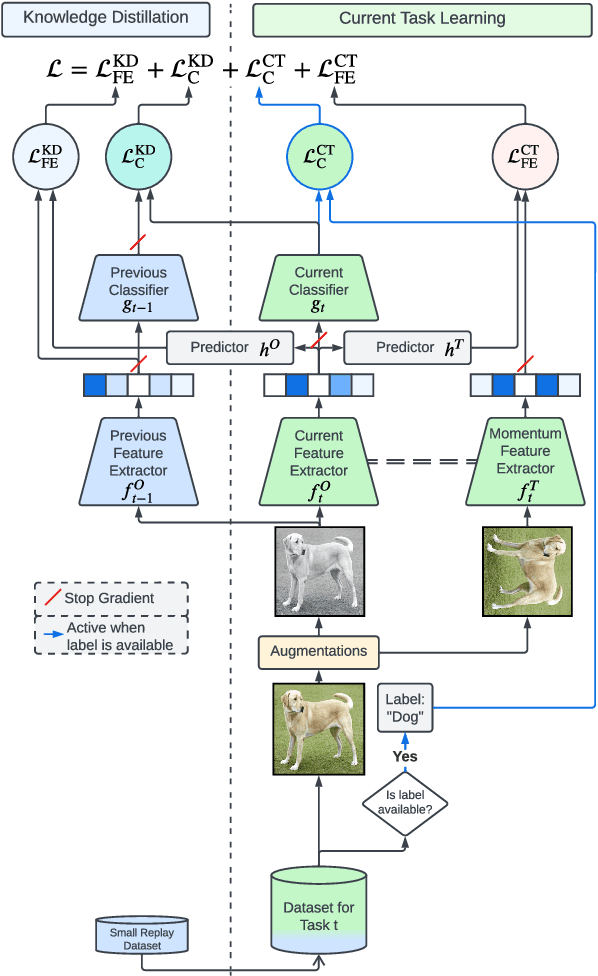
Abstract:Self-supervised learning (SSL) has shown remarkable performance in computer vision tasks when trained offline. However, in a Continual Learning (CL) scenario where new data is introduced progressively, models still suffer from catastrophic forgetting. Retraining a model from scratch to adapt to newly generated data is time-consuming and inefficient. Previous approaches suggested re-purposing self-supervised objectives with knowledge distillation to mitigate forgetting across tasks, assuming that labels from all tasks are available during fine-tuning. In this paper, we generalize self-supervised continual learning in a practical setting where available labels can be leveraged in any step of the SSL process. With an increasing number of continual tasks, this offers more flexibility in the pre-training and fine-tuning phases. With Kaizen, we introduce a training architecture that is able to mitigate catastrophic forgetting for both the feature extractor and classifier with a carefully designed loss function. By using a set of comprehensive evaluation metrics reflecting different aspects of continual learning, we demonstrated that Kaizen significantly outperforms previous SSL models in competitive vision benchmarks, with up to 16.5% accuracy improvement on split CIFAR-100. Kaizen is able to balance the trade-off between knowledge retention and learning from new data with an end-to-end model, paving the way for practical deployment of continual learning systems.
Centaur: Federated Learning for Constrained Edge Devices
Nov 12, 2022



Abstract:Federated learning (FL) on deep neural networks facilitates new applications at the edge, especially for wearable and Internet-of-Thing devices. Such devices capture a large and diverse amount of data, but they have memory, compute, power, and connectivity constraints which hinder their participation in FL. We propose Centaur, a multitier FL framework, enabling ultra-constrained devices to efficiently participate in FL on large neural nets. Centaur combines two major ideas: (i) a data selection scheme to choose a portion of samples that accelerates the learning, and (ii) a partition-based training algorithm that integrates both constrained and powerful devices owned by the same user. Evaluations, on four benchmark neural nets and three datasets, show that Centaur gains ~10% higher accuracy than local training on constrained devices with ~58% energy saving on average. Our experimental results also demonstrate the superior efficiency of Centaur when dealing with imbalanced data, client participation heterogeneity, and various network connection probabilities.
Orchestra: Unsupervised Federated Learning via Globally Consistent Clustering
May 23, 2022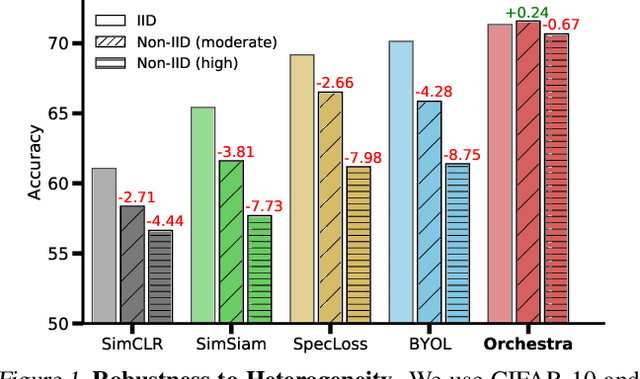



Abstract:Federated learning is generally used in tasks where labels are readily available (e.g., next word prediction). Relaxing this constraint requires design of unsupervised learning techniques that can support desirable properties for federated training: robustness to statistical/systems heterogeneity, scalability with number of participants, and communication efficiency. Prior work on this topic has focused on directly extending centralized self-supervised learning techniques, which are not designed to have the properties listed above. To address this situation, we propose Orchestra, a novel unsupervised federated learning technique that exploits the federation's hierarchy to orchestrate a distributed clustering task and enforce a globally consistent partitioning of clients' data into discriminable clusters. We show the algorithmic pipeline in Orchestra guarantees good generalization performance under a linear probe, allowing it to outperform alternative techniques in a broad range of conditions, including variation in heterogeneity, number of clients, participation ratio, and local epochs.
FLAME: Federated Learning Across Multi-device Environments
Feb 17, 2022


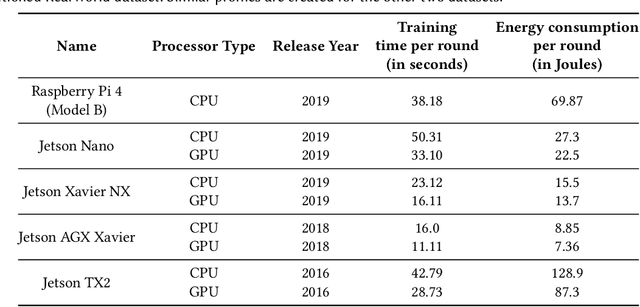
Abstract:Federated Learning (FL) enables distributed training of machine learning models while keeping personal data on user devices private. While we witness increasing applications of FL in the area of mobile sensing, such as human-activity recognition, FL has not been studied in the context of a multi-device environment (MDE), wherein each user owns multiple data-producing devices. With the proliferation of mobile and wearable devices, MDEs are increasingly becoming popular in ubicomp settings, therefore necessitating the study of FL in them. FL in MDEs is characterized by high non-IID-ness across clients, complicated by the presence of both user and device heterogeneities. Further, ensuring efficient utilization of system resources on FL clients in a MDE remains an important challenge. In this paper, we propose FLAME, a user-centered FL training approach to counter statistical and system heterogeneity in MDEs, and bring consistency in inference performance across devices. FLAME features (i) user-centered FL training utilizing the time alignment across devices from the same user; (ii) accuracy- and efficiency-aware device selection; and (iii) model personalization to devices. We also present an FL evaluation testbed with realistic energy drain and network bandwidth profiles, and a novel class-based data partitioning scheme to extend existing HAR datasets to a federated setup. Our experiment results on three multi-device HAR datasets show that FLAME outperforms various baselines by 4.8-33.8% higher F-1 score, 1.02-2.86x greater energy efficiency, and up to 2.02x speedup in convergence to target accuracy through fair distribution of the FL workload.
ColloSSL: Collaborative Self-Supervised Learning for Human Activity Recognition
Feb 01, 2022
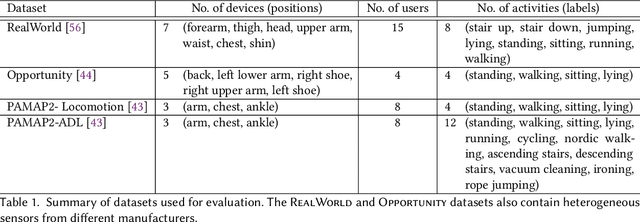

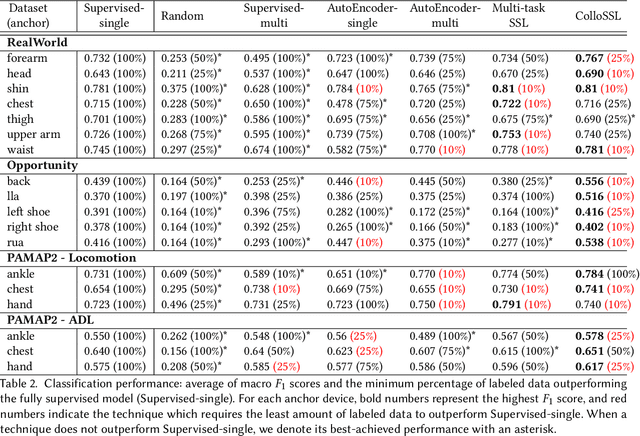
Abstract:A major bottleneck in training robust Human-Activity Recognition models (HAR) is the need for large-scale labeled sensor datasets. Because labeling large amounts of sensor data is an expensive task, unsupervised and semi-supervised learning techniques have emerged that can learn good features from the data without requiring any labels. In this paper, we extend this line of research and present a novel technique called Collaborative Self-Supervised Learning (ColloSSL) which leverages unlabeled data collected from multiple devices worn by a user to learn high-quality features of the data. A key insight that underpins the design of ColloSSL is that unlabeled sensor datasets simultaneously captured by multiple devices can be viewed as natural transformations of each other, and leveraged to generate a supervisory signal for representation learning. We present three technical innovations to extend conventional self-supervised learning algorithms to a multi-device setting: a Device Selection approach which selects positive and negative devices to enable contrastive learning, a Contrastive Sampling algorithm which samples positive and negative examples in a multi-device setting, and a loss function called Multi-view Contrastive Loss which extends standard contrastive loss to a multi-device setting. Our experimental results on three multi-device datasets show that ColloSSL outperforms both fully-supervised and semi-supervised learning techniques in majority of the experiment settings, resulting in an absolute increase of upto 7.9% in F_1 score compared to the best performing baselines. We also show that ColloSSL outperforms the fully-supervised methods in a low-data regime, by just using one-tenth of the available labeled data in the best case.
Tiny, always-on and fragile: Bias propagation through design choices in on-device machine learning workflows
Jan 26, 2022
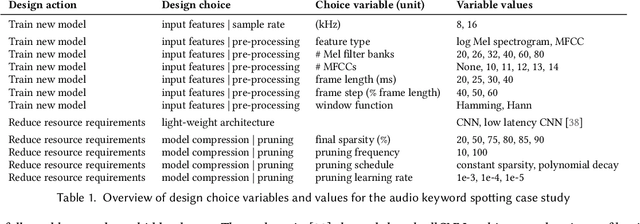
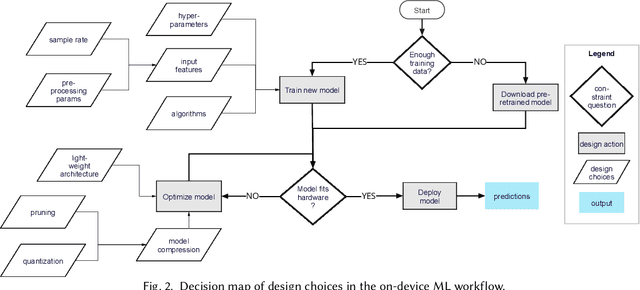

Abstract:Billions of distributed, heterogeneous and resource constrained smart consumer devices deploy on-device machine learning (ML) to deliver private, fast and offline inference on personal data. On-device ML systems are highly context dependent, and sensitive to user, usage, hardware and environmental attributes. Despite this sensitivity and the propensity towards bias in ML, bias in on-device ML has not been studied. This paper studies the propagation of bias through design choices in on-device ML development workflows. We position reliability bias, which arises from disparate device failures across demographic groups, as a source of unfairness in on-device ML settings and quantify metrics to evaluate it. We then identify complex and interacting technical design choices in the on-device ML workflow that can lead to disparate performance across user groups, and thus reliability bias. Finally, we show with an empirical case study that seemingly innocuous design choices such as the data sample rate, pre-processing parameters used to construct input features and pruning hyperparameters propagate reliability bias through an audio keyword spotting development workflow. We leverage our insights to suggest strategies for developers to develop fairer on-device ML.
FRuDA: Framework for Distributed Adversarial Domain Adaptation
Dec 26, 2021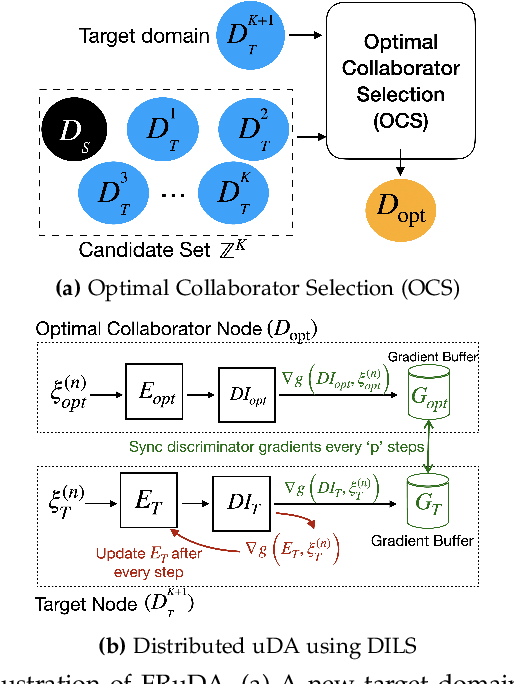
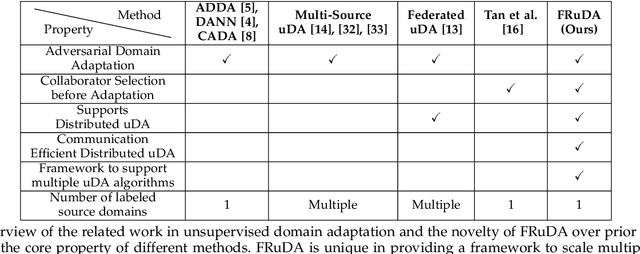
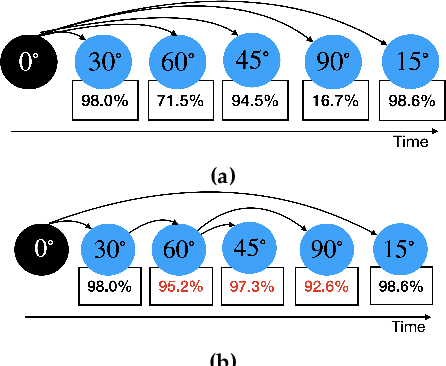

Abstract:Breakthroughs in unsupervised domain adaptation (uDA) can help in adapting models from a label-rich source domain to unlabeled target domains. Despite these advancements, there is a lack of research on how uDA algorithms, particularly those based on adversarial learning, can work in distributed settings. In real-world applications, target domains are often distributed across thousands of devices, and existing adversarial uDA algorithms -- which are centralized in nature -- cannot be applied in these settings. To solve this important problem, we introduce FRuDA: an end-to-end framework for distributed adversarial uDA. Through a careful analysis of the uDA literature, we identify the design goals for a distributed uDA system and propose two novel algorithms to increase adaptation accuracy and training efficiency of adversarial uDA in distributed settings. Our evaluation of FRuDA with five image and speech datasets show that it can boost target domain accuracy by up to 50% and improve the training efficiency of adversarial uDA by at least 11 times.
 Add to Chrome
Add to Chrome Add to Firefox
Add to Firefox Add to Edge
Add to Edge